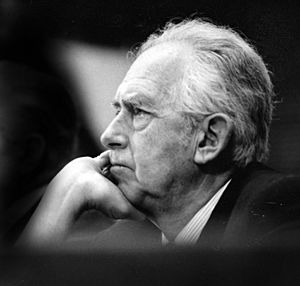János Szentágothai facts for kids
Quick facts for kids
János Szentágothai
|
|
|---|---|

János Szentágothai in 1981
|
|
| Born | 31 October 1912 Pestújhely,
|
| Died | 8 September 1994 (aged 81) |
| Spouse(s) | Alice Biberauer |
| Children | Katalin Klára Mária Krisztina |
| Awards | Member of Hungarian Academy of Sciences Fellow of the Royal Society |
| Scientific career | |
| Institutions | Semmelweis University |
János Szentágothai (born October 31, 1912 – died September 8, 1994) was a famous Hungarian scientist. He was an anatomist, which means he studied the structure of living things, especially the human body. He was also a Professor, a Member of Parliament, and the President of the Hungarian Academy of Sciences.
In 2012, UNESCO honored his 100th birthday because of his important work.
Contents
János Szentágothai's Life
János Szentágothai was born in Budapest in 1912. His birth name was János Schimert. He came from a family of doctors. His father, Dr. Gustav Schimert, and his mother, Margit Antal, were both part of this medical family.
He went to a German grammar school in Budapest. In 1930, he started studying medicine at Peter Pázmány University. Four of his brothers also studied there. He became a doctor in 1936.
His Family Life
In 1938, János married Alice Biberauer. They met through a student group. They had three daughters: Catherine (born 1939), Clare (born 1941), and Maria Christina (born 1951). All three of their daughters also chose to work in the medical field.
János Szentágothai had four brothers who were also doctors. They lived in the United States and Germany. In his free time, he enjoyed working with plants at his weekend home in Révfülöp.
His Work as a Scientist
János Szentágothai began his medical studies in 1930 at Budapest University. In his first year, he joined Professor Mihály Lenhossék's team as a research student. He worked in the Department of Anatomy.
After becoming a doctor in 1936, he continued teaching in Budapest. He became an Associate Professor in 1942. During World War II, he worked as a physician and airman. He was also a prisoner of war. He returned home in 1946.
Research and Discoveries
After the war, he went to Pécs University Medical School. There, he became the Head of the Anatomy Department. He studied the vestibular system, which helps with balance. He also looked into neuroendocrinology, which is about how the nervous system and hormones work together.
At Pécs, he did new and exciting work in neuroanatomy, which is the study of the structure of the nervous system. In 1948, he became a member of the Hungarian Academy of Sciences. In 1961, he helped start the first department in Hungary to use electron microscopes for brain research.
Leading the Anatomy Department
In 1963, he moved back to Budapest. He became the head of the Anatomy Department at Semmelweis University School of Medicine. Here, he mainly focused on the cerebellum (a part of the brain that controls movement) and how the cerebral cortex (the outer layer of the brain) works. He also did experiments on the spinal cord and how reflexes work.
In 1967, he became a full member of the Hungarian Academy of Sciences. He led the department until 1977. He officially retired from teaching in 1986. A famous artist named Ferenc Kiss drew pictures for Szentágothai's textbook. This textbook was translated into thirteen languages and had over a hundred editions!
His Public Service
In 1956, while in Pécs, János Szentágothai was the chairman of a group called the Revolutionary Committee of Intellectuals. He didn't return to public life until 1973. That year, he was chosen as the vice-president of the Hungarian Academy of Sciences.
Four years later, he became the president of the Academy. Because of this, he left his job as a university department head. In 1985, he became a member of the Hungarian Parliament. He was involved in important changes in Hungary during that time. János Szentágothai and his wife are buried in Budapest.
Awards and Honors
János Szentágothai received many important awards for his scientific work:
- Kossuth Prize (1950)
- State Fee Degree (1970) – for his work on the nervous system.
- Karl Spencer Lashley Award (1973)
- Academic Gold Medal (1985)
- The Hungarian Order of Merit Cross with the Star (1992)
- Fellow of the Royal Society (meaning he was recognized by a very old and respected scientific group in the UK)
Sources
- Réthelyi Nicholas John Szentágothai. In: Zs to Hungarian scientist from the lexicon. Spices. Ferenc Nagy. Budapest: Better, MTESZ; OMIKK. 1997th 762–764. P.. ISBN: 963-85433-5-3
- Bela Flerkó John Szentágothai. Budapest: Academic Press, 1998th (The last Hungarian scientists) ISBN: 963-05-7490-X
- Bela fisherman John Szentágothai (1912–1994), In: Famous Hungarian doctors. Eds. Kapronczay Charles E. Water New Year's Eve. Bp: Galen, 2000, 126–131.
- Réthelyi Nicholas John Szentágothai. In: National anniversary 2012th Editor: John Eston. Bp: Balassi Institute, 2012. 5–8. (PDF format. Anniversary National 2012)
- Hungary nagylexikon XVI. (Sel-Sat). Spices. Lamb Lászlóné. Budapest: Hungarian Grand Lexicon. 2003rd 644 of P.. ISBN: 963-9257-15-X
- Choice – Parliamentary Almanac 1990, Budapest: Local Propaganda and Publishing Company, 1990, 233 old.
| Cultural offices | ||
|---|---|---|
| Preceded by Tibor Erdey-Grúz |
President of the Hungarian Academy of Sciences 1976–1985 |
Succeeded by Iván T. Berend |

